Crassula ovata
Crassula ovata (Miller) Druce
Family: Crassulaceae
Common names: kerky bush, jade plant, pink joy (Eng.); beestebul, kerkij, kerky, plakkies (Afr.); t'karkai (Khoi); umxhalagube (X) (= Crassula argentea, C. portulacea)
SA Tree No: 137.3
Introduction
This is probably the most commonly grown crassula in South Africa and well-known as a container plant all over the world, both indoors and outdoors.
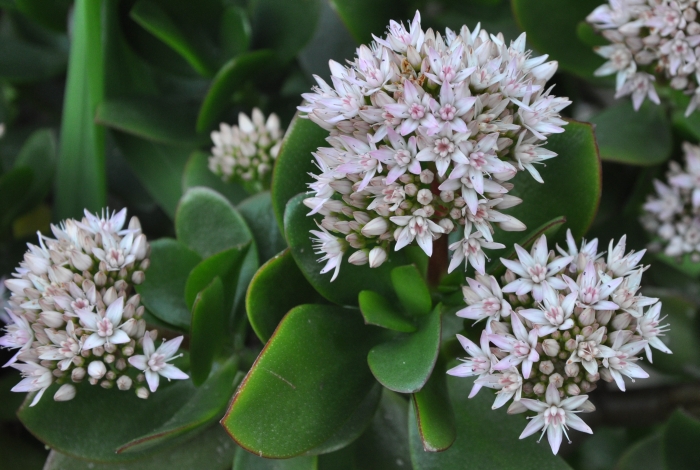
Description
Description
A large well-branched, compact, rounded, evergreen shrub 1 - 3 m tall with glossy, dark grey-green, oval, succulent leaves and rounded heads of pink flowers in winter-spring. The stem is stout and gnarled and gives the impression of great age, and its branches are also short and stubby but well-proportioned. Branches are succulent, grey-green in colour and in older specimens the bark peels in horizontal brownish strips.
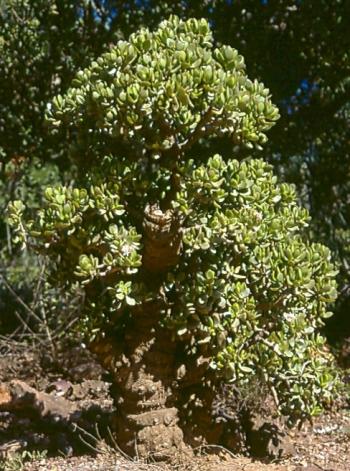
The leaves are 30 - 90 mm long and 18 - 40 mm wide, oval to elliptic, often with a red margin and a somewhat pointed end. They are in opposite pairs, the one pair arranged at right angles to the next, and they are clustered towards the ends of the branches. During the cool winter months (June-August) the bush is covered in masses of sweetly scented, pretty pale-pink, star-shaped flowers in tight rounded bunches . The flowers develop into small capsules, each holding many tiny seeds.

Crassula ovata is very similar to Crassula arborescens. C. arborescens occurs only in the Little and Central Karoo and has a distinct waxy bloom on its leaves, and its leaves are almost spherical.
Conservation Status
Status
Least Concern (LC). Crassula ovata is widespread and not declining.
Distribution and habitat
Distribution description
Crassula ovata is a prominent element of the Eastern Cape and KwaZulu-Natal valley thicket vegetation, together with a variety of aloes, euphorbias, Portulacaria afra and other succulents. It occurs from Willowmore to East London and northwards to Queenstown and KwaZulu-Natal where it grows on rocky hillsides.
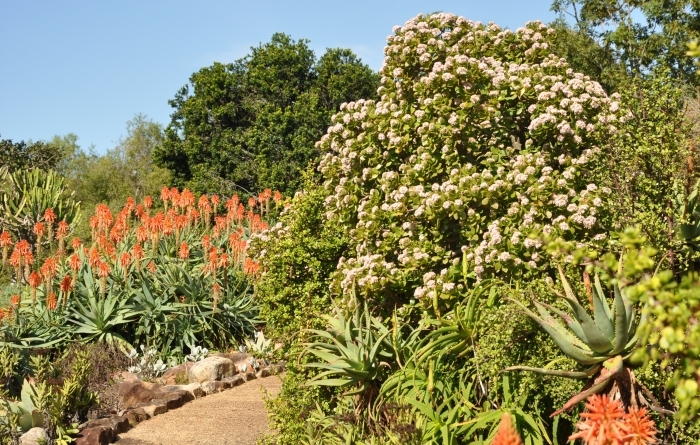
Derivation of name and historical aspects
History
Crassula ovata was first described in England in 1768. The name Crassula is the diminutive of the Latin crassus which means thick or fat, referring to the fleshy nature of the genus as a whole. The species name ovata means egg-shaped, referring to the leaves.
The genus Crassula is one of the most diverse succulent genera, varying from tiny moss-like annual plants to 2m tall succulent 'trees' like Crassula ovata. There are more than 300 Crassula species of which approx. 150 are found in southern Africa, where they are widespread but concentrated in the semi-arid winter-rainfall areas. The centre of distribution of this genus is in southern Africa, but they extend beyond Africa into Europe, America, Australia, New Zealand and the southern islands.
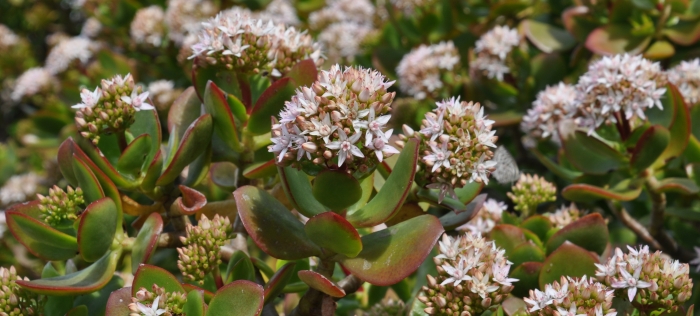
Ecology
Ecology
Crassulas have a special way of reducing water loss from their leaves without limiting their ability to photosynthesise, known as Crassulacean Acid Metabolism or CAM. All plants need CO2 (carbon dioxide) for photosynthesis. Most plants take in CO2 during daylight hours through their stomata (pores in the leaves) and can't avoid losing water at the same time through these open pores. In Crassula the stomata are closed during the day but open at night when the CO2 taken in is stored in the form of organic crassulacean acids. During the day, these acids are broken down and the CO2 released is re-used in the photosynthetic process. In this way they lose much less water yet can photosyntesise normally during the daylight hours. Furthermore, during extremely dry periods they won't even open their stomata at night, and will re-cycle the CO2 within the cells. They won't be able to grow at all but the cells will be kept healthy - this is known as CAM-idling.
In addition to being a CAM plant, and having succulent water-storing stems, and leaves and swollen roots that give it the ability to survive droughts, this crassula can also survive being grazed, trodden on or knocked over, as it is able to root from any piece of stem, even a single leaf.
The flowers attract bees, wasps, flies, beetles and butterflies. The fine dust-like seed is dispersed by the wind. Tortoises love the leaves but rarely devour them completely. Any discarded leaves left around the foot of the plant send down roots and grow into new plants. The stems also make handy bases for wasps to build their nests.
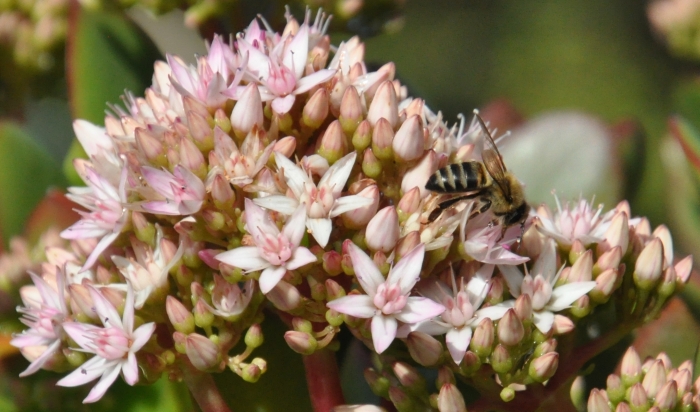
Uses
Use
The Khoi and other African tribes ate the roots, which they grated and cooked and then ate with thick milk. The leaves were also used medicinally, boiled in milk as a remedy for diarrhoea, and used to treat epilepsy, corns and as a purgative.
In the Far East, Germany and the USA it is traditionally grown in square porcelain tubs with 'lion feet' to bring good financial luck, and has attracted more common names including the money tree, penny plant, dollar plant and tree of happiness.
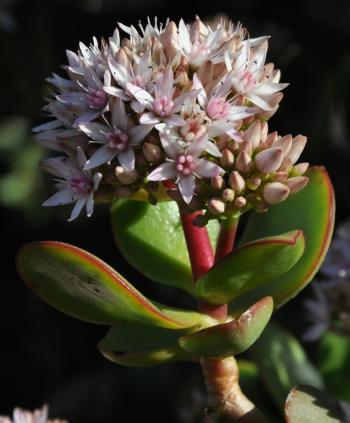
Growing Crassula ovata
Grow
Crassula ovata is easy to grow in normal loam soil, but it must have good drainage. It thrives in full sun or semi-shade, but will flower best in a sunny position. Feed with plenty of compost, organic or inorganic fertilisers, and take care not to overwater. This plant is tolerant of drought, wind and coastal conditions. Although it comes from a frost-free environment, it should tolerate a winter minmum of -1° C (zone 10) but is best protected from frost to prevent the flowers from being damaged.
Crassula ovata is a wonderful sculptural plant for pots, tubs, rockeries, retaining walls and gravel gardens and is the ideal plant for a water-wise garden. It can also be grown in pots indoors. To induce a potted specimen to flower, move it into a sunny or brightly lit position during summer and autumn - but if it has been in a cool low-light spot remember to introduce it to stronger light gradually or the leaves will be scorched. Also, don't put it behind glass in full sun, rather move it to an outside sunny spot or into a spot that receives bright light but no direct sun. Particularly with potted specimens, remember that it needs little water, so water sparingly in summer and withold water during winter. It's best to drench the soil and then allow it to dry out before watering again. The plant will tolerate periods of drought effortlessly but will soon rot if left to stand in wet soil.
Propagate by seed or cuttings. Seed can be sown in spring, summer or autumn in frost-free areas. Seedlings can be watered with a fungicide to prevent damping off. Cuttings root at any time of the year but optimal rooting is achieved during summer. Keep them fairly dry to prevent them from rotting.
Variegated forms and cultivars have been available in Europe, Australasia and the USA since the 1800s and are now becoming popular in South Africa. Some of these cultivars have names like 'Gollum' and 'Hobbit'.
References
- Court, Doreen, 2000 Succulent Flora of Southern Africa. A.A. Balkema, Rotterdam
- Eggli, Urs (Ed). 2002 Illustrated Handbook of Succulent Plants, Crassulaceae Illustrated Handbook of Succulent Plants. Springer, Berlin
- Leistner, O.A. (ed.) 2000 Seed plants of southern Africa: families and genera, Strelitzia 10. National Botanical Institute, Pretoria
- Palmer, E. and Pitman, N. 1972 Trees of Southern Africa. A.A. Balkema, Cape Town
- Smith, C.A. 1966 Common Names of South African Plants. Dept. of Agricultural Technical Services, Botanical Survey Memoir No 35, Government Printer.
Credits
Christien Malan & Alice Notten
Kirstenbosch National Botanical Garden
May 2005
Plant Attributes:
Plant Type: Shrub, Succulent
SA Distribution: Eastern Cape, KwaZulu-Natal
Soil type: Sandy, Clay, Loam
Flowering season: Winter
PH: Acid, Alkaline, Neutral
Flower colour: Pink
Aspect: Full Sun, Morning Sun (Semi Shade)
Gardening skill: Easy
Special Features:
Horticultural zones











Rate this article
Article well written and informative
Rate this plant
Is this an interesting plant?
Login to add your Comment
Back to topNot registered yet? Click here to register.